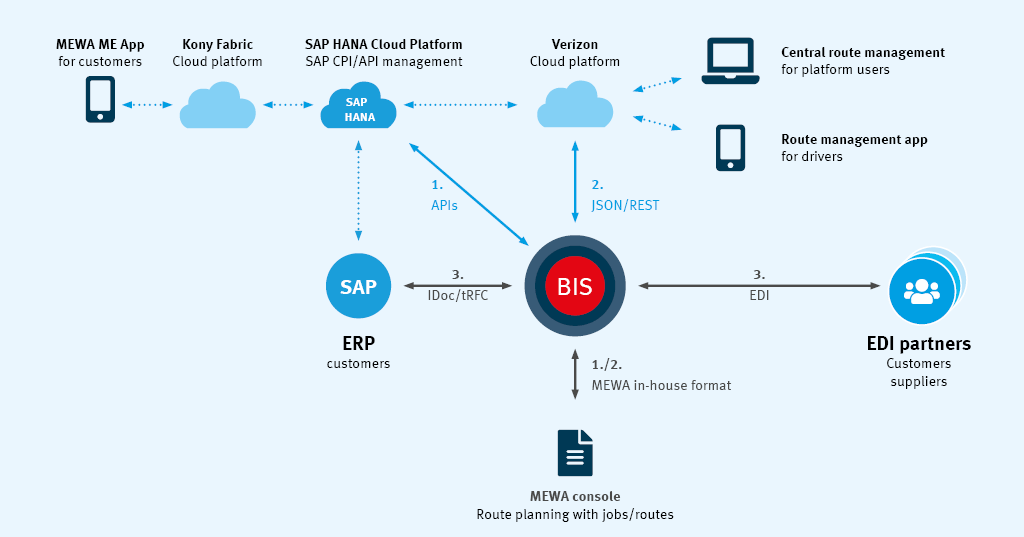
Safe, clean, hygienic, and always freshly available: That’s what we expect of our workwear. As an experienced textile management supplier, MEWA knows what its customers want – and has been meeting those expectations daily for over 100 years. These days, the long-established company from Germany’s beautiful Wiesbaden is helped by state-of-the-art IT technology. At the centre is the SEEBURGER BIS platform with its API solution. Recently, MEWA used it to integrate two further innovative cloud solutions for vehicle routing und customer service.
Textile rental is growing in popularity across industries. Renting textiles for professional use is not only economical but also evironmentally-friendly. It’s therefore no surprise that MEWA is continuously growing and developing its successful business model.
To ensure that clients receive the clothing they’ve ordered in full and on time, MEWA needs end-to-end processes and future-orientated technologies in all areas of its business. The cloud solutions above are examples of the digitalisation in progress at MEWA, all powered by the multi-talented SEEBURGER BIS platform to ensure optimal use.
As it became clear that the previous vehicle routing software was not being regularly maintained and updated, the decision was taken to integrate a modern, cloud-based standard solution into the MEWA IT environment. The aim: fast access at all times for the dispatchers in head office and the drivers on the road to the information they need. The new solution includes a module for the employees in fleet management to optimise vehicle routing as well as a mobile app for our 700 or so drivers with an electronic route list, navigation and up-to-date client details, permanently networked with the backend office at MEWA.
Connecting old and new
IT experts know the problem: how can you get data from a legacy back-end system to a browser-based user interface at a decent speed and in the right format? And how can you integrate the mobile app used by the drivers? ‟We’d had positive experience with the SEEBURGER Business Integration Server (BIS) over a number of years. Therefore, it was an easy decision to also deploy their API solution. Through API integration with JSON/REST, we could integrate the standard SaaS solution for vehicle routing into the MEWA business console.” (see figure 1, scenario 2.)
“However, we soon learned that a fast data flow can have its own issues; the transmission volumes proved to be too high for Verizon Connect, the web platform used for the new vehicle routing tool. The experts at SEEBURGER found a solution: now, the BIS server splits the calls made on the web service into packets of maximum 500 data sets. Now, the data can flow unhindered.”
Effective service processes
Using the back-end data, the vehicle routing system is now used to manage the entire routing operation. Tasks and routes are automatically created, which the fleet manager can dynamically alter, optimise and add new jobs to. This information is then sent to the drivers‘ smartphones as structured data. The tool supports route planning and optimisation with analysis, monitoring and documentation based on regularly updated data. This includes the number of miles on the clock in the vehicles, their fuel consumption and any error messages from a vehicle’s CAN bus. ‟Having fast access to this and other data from various systems is vital to future-proofing our processes” says Matthias Kun, Head of fleet management and IT systems.
In addition, this new solution includes a mobile application that provides the 700 drivers with an electronic route list, integrated navigation and access to MEWA’s CRM system on their mobile devices. This means that returns can be entered into the system straight away and tasks managed when not on site. A major advantage is that drivers use a smartphone or tablet and no longer need a dedicated PDA. This new standard solution has been welcomed by both fleet management and drivers, as the web-based interface has an intuitive design and the driver’s app is easy to use. Omar Lakniti, applications developer at MEWA explains: “As we can use BIS to exchange our data in any format we may need, we have so many more options for integrating innovate solutions quickly and easily into our current IT infrastructure.”
Send your workwear for repair by app
Customers value the high quality of MEWA‘s textiles and service. This includes repairs if a button comes off or if a sleeve gets ripped. If this happens, wearers can immediately register their clothing for a repair via the MEWA ME service app. Furthermore, all staff can look at the app to quickly see what clothing is currently being laundered and what is hanging in the lockers, ready to wear. New users can also use the app to share their clothes size with MEWA.
SEEBURGER’s Business Integration Server (BIS) provides a secure basis for data flow between the back-end and the app. BIS is also responsible for the multi-level integration of the MEWA ME app over the SAP HANA cloud platform with the BIS API-solution web services as its modern façade, ensuring a synchronous bi-directional flow with the MEWA business console ( see figure 1, scenario 1.)
Omar Lakniti is pleased: “The Business Integration Suite gives us security, also for the integration of cloud services and mobile applications.” And that with the same reliability and performance as its standard B2B/EDI integration in SAP. Which, incidentally, has been succssfully used for the last 15 years at MEWA for handling order and invoicing processes with end customers and suppliers (see figure 1, scenario 3.).
 Figure 1: API integration of the mobile app MEWA ME and the central vehicle routing management solution ZTM
Figure 1: API integration of the mobile app MEWA ME and the central vehicle routing management solution ZTMIn a nutshell: This is how MEWA uses the SEEBURGER BIS platform and benefits from seamlessly integrated processes:
- BIS connects modern web and mobile apps with legacy systems
- Deep backend integration into business console developed in-house
- High processing speed for mobile app and management solution
- Secure internet communication via BIS
- High efficiency as several scenarios are controlled on one platform
- Standard B2B/EDI integration in SAP for ordering and invoicing processes
Source: https://blog.seeburger.com/mewa-optimised-vehicle-routing-and-sustainable-customer-service/
 expertise
expertise
